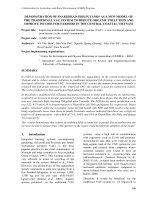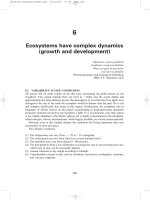A New Ecology - Systems Perspective - Intro ppsx
Bạn đang xem bản rút gọn của tài liệu. Xem và tải ngay bản đầy đủ của tài liệu tại đây (808.33 KB, 13 trang )
A New Ecology: Systems Perspective
Else_SP-Jorgensen_prelims.qxd 4/11/2007 18:24 Page i
Front cover photo is by B.D. Fath and shows Møns Klint, Denmark.
The back cover photos show (from left to right) (1) a danish beech forest (Ryget
Skov), (2) Krimml Falls in Austria, (3) part of the shore of Namchu Lake in Tibet,
(4) Crater Lake, Oregan, USA, and (5) Natron Lake, Tanzania and were taken by
S.E. Jørgensen (1 and 4), B.D. Fath (2), and M.V. Jørgensen (3 and 5).
Else_SP-Jorgensen_prelims.qxd 4/11/2007 18:24 Page ii
A New Ecology
Systems Perspective
Sven E. Jørgensen
Environmental Chemistry Section
Royal Danish School of Pharmacy
DK-2100 Copenhagen, Denmark
Simone Bastianoni
Department of Chemical and
Biosystems Sciences
University of Siena
53100 Siena, Italy
Felix Müller
Ecology Centre
University of Kiel
24118 Kiel, Germany
Bernard C. Patten
Institute of Ecology
University of Georgia
Athens, GA 30602-2602, USA
Brian D. Fath
Biology Department
Towson University
Towson, MD 21252, USA
João C. Marques
Department of Zoology
Institute of Marine Research (IMAR),
University of Coimbra
3004-517 Coimbra, Portugal
Søren N. Nielsen
Environmental Chemistry Section
Royal Danish School of Pharmacy
DK-2100 Copenhagen, Denmark
Enzo Tiezzi
Department of Chemical and
Biosystems Sciences
University of Siena
53100 Siena, Italy
Robert E. Ulanowicz
Chesapeake Biological Laboratory
P.O. Box 38, 1 Williams Street
Solomons, MD 20688-0038, USA
Amsterdam
•
Boston
•
Heidelberg
•
London
•
New York
•
Oxford
Paris
•
San Diego
•
San Francisco
•
Singapore
•
Sydney
•
Tokyo
Else_SP-Jorgensen_prelims.qxd 4/11/2007 18:24 Page iii
Elsevier
Linacre House, Jordan Hill, Oxford OX2 8DP, UK
Radarweg 29, PO Box 211, 1000 AE Amsterdam, The Netherlands
First edition 2007
Copyright © 2007 Elsevier B.V. All rights reserved
No part of this publication may be reproduced, stored in a retrieval system
or transmitted in any form or by any means electronic, mechanical, photocopying,
recording or otherwise without the prior written permission of the publisher
Permissions may be sought directly from Elsevier’s Science & Technology Rights
Department in Oxford, UK: phone (+44) (0) 1865 843830; fax (+44) (0) 1865 853333;
email: Alternatively you can submit your request online by
visiting the Elsevier web site at and selecting
Obtaining permission to use Elsevier material
Notice
No responsibility is assumed by the publisher for any injury and/or damage to persons
or property as a matter of products liability, negligence or otherwise, or from any use
or operation of any methods, products, instructions or ideas contained in the material
herein. Because of rapid advances in the medical sciences, in particular, independent
verification of diagnoses and drug dosages should be made
Library of Congress Cataloging in Publication Data
A catalog record is available from the Library of Congress
British Library Cataloguing in Publication Data
A catalogue record is available from the British Library
ISBN: 978-0-444-53160-5
Printed and bound in The Netherlands
07 08 09 10 11 10 9 8 7 6 5 4 3 2 1
For information on all Elsevier publications
visit our website at books.elsevier.com
Else_SP-Jorgensen_prelims.qxd 4/11/2007 18:24 Page iv
CONTENTS
Preface ix
1. Introduction: A New Ecology is Needed 1
1.1 Environmental management has changed 1
1.2 Ecology is changing 2
1.3 Book outline 3
2. Ecosystems have Openness (Thermodynamic) 7
2.1 Why must ecosystems be open? 7
2.2 An isolated system would die (maximum entropy) 8
2.3 Physical openness 13
2.4 The second law of thermodynamics interpreted for open systems 18
2.5 Dissipative structure 20
2.6 Quantification of openness and allometric principles 22
2.7 The cell 30
2.8 What about the environment? 31
2.9 Conclusion 32
3. Ecosystems have Ontic Openness 35
3.1 Introduction 35
3.2 Why is ontic openness so obscure? 36
3.3 Ontic openness and the physical world 39
3.4 Ontic openness and relative stability 49
3.5 The macroscopic openness: Connections to thermodynamics 50
3.6 Ontic openness and emergence 53
3.7 Ontic openness and hierarchies 55
3.8 Consequences of ontic openness: a tentative conclusion 56
4. Ecosystems have Directionality 59
4.1 Since the beginnings of ecology 59
4.2 The challenge from thermodynamics 60
4.3 Deconstructing directionality? 62
4.4 Agencies imparting directionality 63
4.5 Origins of evolutionary drive 66
4.6 Quantifying directionality in ecosystems 68
4.7 Demystifying Darwin 74
4.8 Directionality in evolution? 76
4.9 Summary 77
v
Else_SP-Jorgensen_contents.qxd 4/5/2007 12:17 Page v
vi Contents
5. Ecosystems have Connectivity 79
5.1 Introduction 79
5.2 Ecosystems as networks 80
5.3 Food webs 82
5.4 Systems analysis 84
5.5 Ecosystem connectivity and ecological network analysis 86
5.6 Network environ analysis primer 86
5.7 Summary of the major insights cardinal hypotheses (CH)
from network environ analysis 92
5.8 Conclusions 101
6. Ecosystems have Complex Dynamics (Growth and Development) 103
6.1 Variability in life conditions 103
6.2 Ecosystem development 105
6.3 Orientors and succession theories 112
6.4 The maximum power principle 115
6.5 Exergy, ascendency, gradients, and ecosystem development 120
6.6 Support for the presented hypotheses 125
6.7 Toward a consistent ecosystem theory 133
6.8 Exergy balances for the utilization of solar radiation 139
6.9 Summary and conclusions 141
7. Ecosystems have Complex Dynamics – Disturbance and Decay 143
7.1 The normality of disturbance 143
7.2 The risk of orientor optimization 151
7.3 The characteristics of disturbance 152
7.4 Adaptability as a key function of ecosystem dynamics 156
7.5 Adaptive cycles on multiple scales 160
7.6 A case study: Human disturbance and retrogressive dynamics 164
7.7 Summary and conclusions 166
8. Ecosystem Principles have Broad Explanatory Power in Ecology 167
8.1 Introduction 167
8.2 Do ecological principles encompass other proposed
ecological theories?: Evolutionary theory 168
8.3 Do ecological principles encompass other proposed
ecological theories?: Island biogeography 176
8.4 Do ecological principles encompass other proposed
ecological theories?: Latitudinal gradients in biodiversity 180
8.5 Do ecological principles encompass other proposed
ecological theories?: Optimal foraging theory 184
8.6 Do ecological principles encompass other proposed
ecological theories?: Niche theory 187
Else_SP-Jorgensen_contents.qxd 4/5/2007 12:17 Page vi
8.7 Do ecological principles encompass other proposed
ecological theories?: Liebig’s law of the minimum 191
8.8 Do ecological principles encompass other proposed
ecological theories?: The river continuum concept (RCC) 194
8.9 Do ecological principles encompass other proposed
ecological theories?: Hysteresis in nature 196
8.10 Conclusions 198
9. Ecosystem Principles have Applications 199
9.1 Introduction 199
9.2 Entropy production as an indicator of ecosystem trophic state 200
9.3 The use of ecological network analysis (ENA) for the simulation
of the interaction of the american black bear and its environment 206
9.4 Applications of network analysis and ascendency to South Florida
ecosystems 210
9.5 The application of eco-exergy as ecological indicator for
assessment of ecosystem health 218
9.6 Emergy as ecological indicator to assess ecosystem health 221
9.7 The eco-exergy to empower ratio and the efficiency of ecosystems 228
9.8 Application of eco-exergy and ascendency as ecological indicator
to the Mondego Estuary (Portugal) 231
9.9 Conclusions 241
10. Conclusions and Final Remarks 243
10.1 Are basic ecological properties needed to explain our observations? 243
10.2 Previous attempts to present an ecosystem theory 243
10.3 Recapitulation of the ecosystem theory 245
10.4 Are there basic ecosystem principles? 246
10.5 Conclusion 248
References 251
Index 273
Contents vii
Else_SP-Jorgensen_contents.qxd 4/5/2007 12:17 Page vii
This page intentionally left blank
PREFACE
The scope of this book is to demonstrate that we do have an ecosystem theory that can be
used to describe ecosystem structure and function. It was previously shown in the book,
Integration of Ecosystem Theories: A Pattern (3rd edition, 2002), that the various contri-
butions to systems ecology are consistent and together form a pattern of ecological
processes. My book with Yuri Svirezhev, Toward a Thermodynamic Theory of Ecosystems
(2004), presented the thermodynamics of this pattern in a mathematical language. This
book, A New Ecology: Systems Perspective, shows that the basic properties of ecosystems
(presented in Chapters 2–7) lead to or are consistent with ten tentative propositions for
ecosystems (Chapter 10), which can be used to explain ecological observations (Chapter 8).
An ecosystem theory is a prerequisite for wider application of ecological sciences in envi-
ronmental management because with the theory it becomes feasible to guide conservation
or environmental management. Chapter 9 shows how the presented ecosystem theory can
be applied to assess ecosystem health, a facet of environmental management. A thermody-
namic interpretation of the evolution is under preparation in my other book with Yuri
Svirezhev, A Thermodynamic Theory of the Evolution, with expected publication in 2007 or
early in 2008. The three books Toward a Thermodynamic Theory of Ecosystems, this book
A New Ecology: Systems Perspective, and the coming one, A Thermodynamic Theory of the
Evolution form a troika that presents a useful ecological theory.
This book has nine authors. The basic outline of the book was formulated during a one-
week brainstorming meeting on the Danish island of Møn in June 2005. All nine authors
have written parts of the book and have reviewed the contributions of the other authors.
The book is therefore a joint effort resulting from close teamwork. I am the first author
because the idea to produce a book about ecosystem theory and systems ecology was initi-
ated by me based on a brainstorming meeting with system ecologists. I edited this book
with Brian Fath after all the authors had exchanged ideas and reviewed the ten chapters.
Brian Fath is therefore considered the second editor of the book. Bai Lian Li (Larry) parti-
cipated in the brainstorming meeting in Møn and he contributed significantly to the out-
line of ideas making up the final book. However, due to his engagement with the
Eco-summit 2007 in China, he was unable to contribute written material for the book. He
is, however, working on a Chinese edition of the book, which we all consider of great
importance as China during the last few years has shown an increased interest in envi-
ronmental problems. This Chinese interest for environmentally sound management is
expected to accelerate in the coming years, which makes a Chinese edition of this book
even more important. Bernie Patten and Enzo Tiezzi were unable to attend the brain-
storming meeting, but they both contributed written material and comments on the
chapters (Photos 1 and 2).
Using my 2004 Stockholm Water Prize, I established a foundation to promote ecosys-
tem theory and integrated environmental assessment. The Foundation’s grants support
brainstorming meetings and travel particularly for young scientists focusing on system
ecology, ecological modelling, and lake management. The foundation is named “William
ix
Else_SP-Jorgensen_preface.qxd 3/29/2007 11:27 Page ix
x Preface
Photo 1: From the brainstorming meeting at Møn, June 2005.
Photo 2: From the brainstorming meeting at Møn, June 2005.
Else_SP-Jorgensen_preface.qxd 3/29/2007 11:27 Page x
Williams’ and Milan Straškraba’s Foundation” after two of my close scientist friends who
passed away in 2002 and 2000. William Williams has contributed significantly to inte-
grated lake management and Milan Straškraba has played a major role in system ecology
in the last two decades of the 20th century. The nine authors express their appreciation to
the foundation for the support that has made it possible to publish this book in the hope
that it will enhance a wider application of ecosystem theory in ecology to explain obser-
vations and to facilitate ecological sound conservation and environmental management.
Sven Erik Jørgensen
Copenhagen, July 2006
Preface xi
Else_SP-Jorgensen_preface.qxd 3/29/2007 11:27 Page xi
This page intentionally left blank









